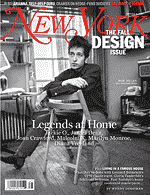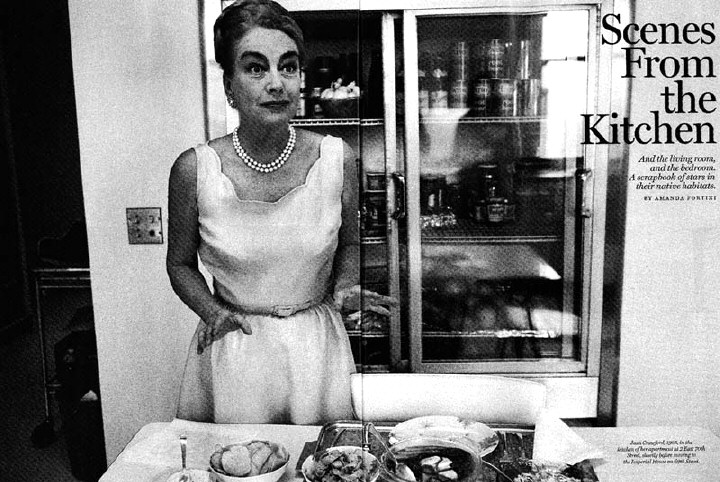Scenes From the Kitchen
by Amanda Fortini
Originally appeared in New York magazine, October 9, 2006
Joan Crawford, 1965, in the kitchen of her apartment at 2 East 70th Street, shortly before moving to the Imperial House on 69th Street.
If these images reveal much about the time in which they were taken—the white shag rug of the sixties, the pro-choice poster of the seventies—they reveal more about the celebrities captured therein. In one photo, Gloria Steinem, miniskirted and bare-legged, stares wearily from her paper-strewn office, subverting the stereotype of the frumpy, single cat lady by holding her own cat in her lap. Or perhaps the cat provided a bit of comfort; Steinem, who would soon testify at the Senate ERA hearings, looks like the pressures of being a feminist icon might have been getting to her. Then there is Gypsy Rose Lee, her bare feet surrounded by countless crumpled drafts of The G-String Murders, her mystery novel-in-progress.
Viewing these photographs, saturated as many are with personal detail, feels slightly illicit, as though one has just rummaged through a stranger’s medicine chest or taken a furtive peek in his refrigerator. But it also demystifies the subjects depicted. (They’re “Just Like Us,” as contemporary tabloids never fail to remind us.) Debbie Harry and Chris Stein might have been rocking CBGB by night, but by day they are engaged in the banal act of making a sandwich in their utterly banal East Village kitchen, complete with animal-print oven mitts and a bowl of change on the fridge.
Of course, the equation changes when the interior is done in minimalist style. What can we know about Barbara Kruger from her spare, loftlike room? But even austerity is an aesthetic choice, a conscious withholding of references. We see Yoko Ono, two years after her husband’s murder, marooned on an immense white iceberg of a sofa, the walls adorned only with an enormous Asian scroll painting and a tiny, indeterminate drawing. The viewer has little in the way of objects to interpret, and Ono’s sunglasses underscore her unwillingness to reveal anything. Yet this decision to convey nothing conveys a great deal. Ono’s rigorously edited room is clearly of a piece with the rigorously organized woman; a person of morning constitutionals and kept-to schedules, of almost military efficiency.
This gets to the particular allure of the photographs: Every interior imparts its secrets about the life its famous owner has lived. And yet the appeal of these images lies as much in what is seen as in what is left to the imagination. The domestic objects—the furniture, the carpeting, the paintings, the tchotchkes—are visual clues inviting endless speculation. Here is Woody Allen, working not among the bohemian clutter of his films but in a stately dining room, an enormous chandelier overhead. Where are the books, the albums, the knickknacks? Were repairs being done in his study, banishing him to this unlived-in room? Or was this the brownstone he shared with Louise Lasser, the one into which they never quite settled?
“Only because history is fetishized in physical objects can one understand it,” Susan Sontag wrote. In one sense, these images are themselves fetishized objects; they are fascinating curiosities. But the physical objects they capture are also historical artifacts, a way of making history concrete. In this sense, we might view them as mini-biographies, visual narratives that disclose not just the aesthetic choices made by the inhabitants, but much about their personalities as well. Some let it all hang out, while others give nothing away.

Joan Crawford and Alfred Steele, 1958, in their East 70th Street
Apartment.


